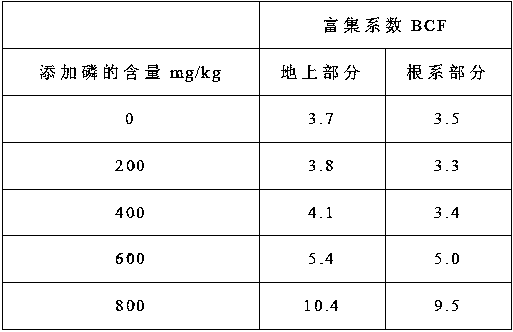Method for repairing arsenic contaminated soil by using pteris vittata
A technology of centipede grass and arsenic pollution, which is applied in the field of centipede grass to restore arsenic-contaminated soil, which can solve the problems of crop yield and quality decline, soil degradation, etc., and achieve the effects of strong adaptability, improved adsorption capacity, and no secondary pollution
- Summary
- Abstract
- Description
- Claims
- Application Information
AI Technical Summary
Problems solved by technology
Method used
Image
Examples
Embodiment 1
[0015] The soil was taken from Hushan Village, Huji Town, Zhongxiang City, Hubei Province. The soil type was clay, with arsenic content of 50 mg / kg, total phosphorus content of 880 mg / kg, available phosphorus of 19.0 mg / kg, and pH of 7.23. Put 5kg of soil in a plastic pot into the air-dried soil passed through a 2mm sieve, apply 0.42kg of urea and 0.34kg of potassium chloride, then put it into 1 experimental pot, repeat the above operation to prepare 5 experimental pots, and conduct 5 different tests on the 5 experimental pots. Treatment: add arsenic compound Na to 5 experimental pots 2 HASO 4 7H2O (analytical pure, purity ≥ 99.7%, Alfa Aesear company, the United States) 400mg / kg, calcium superphosphate Ca(H 2 PO 4 ) 2 , so that the phosphorus content in the soil of the four experimental pots reached 200, 400, 600, and 800 mg / kg respectively, and the remaining one experimental pot did not add Ca(H 2 PO 4 ) 2 , the soil in the 5 experimental pots was balanced for two week...
Embodiment 2
[0031] A method for repairing arsenic-polluted soil with Centipede Grass, comprising the following steps:
[0032] S1: Plow the soil in the arsenic-contaminated area where the soil arsenic content is 60-120mg / kg, then apply urea 60-80kg / mu and potassium chloride 40-60kg / mu, and at the same time apply Ca(H 2 PO 4 ) 2 Make the phosphorus content in the soil reach 200-800mg / kg;
[0033] S2: plant centipede grass seedlings in the soil according to the density of 3000-5000 plants / mu;
[0034] S3: Harvest the aerial part and the root system part of the centipede grass when the centipede grass grows for 100-140 days.
[0035] Soil moisture content is controlled at 25%-35%.
[0036] The arsenic content in the soil of the arsenic-contaminated area treated by this method is obviously reduced by 10%-15%. Can find out from embodiment 1-2 that adding a large amount of phosphorus can improve the adsorption capacity and the enrichment coefficient of centipede grass, phosphorus and arsen...
PUM
 Login to View More
Login to View More Abstract
Description
Claims
Application Information
 Login to View More
Login to View More - R&D
- Intellectual Property
- Life Sciences
- Materials
- Tech Scout
- Unparalleled Data Quality
- Higher Quality Content
- 60% Fewer Hallucinations
Browse by: Latest US Patents, China's latest patents, Technical Efficacy Thesaurus, Application Domain, Technology Topic, Popular Technical Reports.
© 2025 PatSnap. All rights reserved.Legal|Privacy policy|Modern Slavery Act Transparency Statement|Sitemap|About US| Contact US: help@patsnap.com



